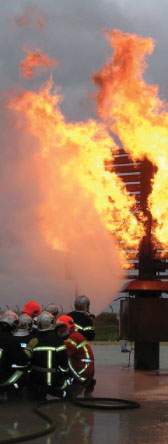
Facilities at the French Training Centre of Airport Firemen include a model of an A320 aircraft, a firewall, a zone for pool fires and a track used to learn how to drive vehicles on uneven ground, such as bankings, bridge crossings, sandy terrain, slopes, narrow passages, and all-terrain airstrips.
Airport fire-fighting incorporates unique challenges and particular circumstances and the training at C2FPA is designed to cover the specific needs of airport operators. All instructors have a background in civil or military aviation, with experience in the rescue and aircraft fire-fighting services (SSLIA) and knowledge of the latest developments in educational methods.
The initial training of the 1,500 heads of operations and firemen involved in the French airport community consists of a three-week training period to complete the civil safety firemen programme. All rescue and aircraft fire-fighting services personnel must complete a specific training period, every three years, in order to maintain their skills. The programmes validated by the DGAC, their theoretical and practical content, as well as the skills and resources brought together by the C2FPA, exceed the requirements of the International Civil Aviation Organization (ICAO). “The high-level resources, methods and practices have made the C2FPA much sought-after today by airports outside metropolitan France,” said Jacques Sabourin, CEO, C2FPA and Delegate General, UAF – L’Union des Aéroports Français. “The French Training Centre of Airport Firemen currently has no equivalent elsewhere in Europe – it may even be the only one of its kind in the world.”
Wildlife hazard prevention planned
Facilities include a model of an A320 aircraft, a firewall, a zone for pool fires and a track used to learn how to drive vehicles on uneven ground, such as bankings, bridge crossings, sandy terrain, slopes, narrow passages, and all-terrain airstrips.
The aircraft model is equipped with 18 modules designed to reproduce the various types of fires that personnel may be confronted with, including engine, landing gear, cabin and cargo compartment. Installation of a Boeing 747-200 type wide-bodied aircraft is scheduled for mid-2008.
“The realism of the simulations contributes to the quality of the training provided by C2FPA. New facilities are in the works, including a zone dedicated to wildlife hazard prevention, which will be operational by the end of this year,” said Sabourin.
C2FPA uses four new generation fire-fighting vehicles approved by the National Commission of Airport Safety Equipment (CNMSA). The high performance vehicles have high acceleration and maximum speeds, remote controlled high outflow foam fire-hose nozzles, portable fire-hose nozzles (foam and powder), and onboard computer management system.
The main building houses the training rooms, each of which is equipped with the latest training tools: a video projector, a computer with a DVD player, an internet connection, a local network and a technical support centre video monitoring terminal.
As physical fitness is essential for fire-fighters, there is also a 70sqm gym.
Environmental sustainability
Sustainable development was a key factor in the choice of the centre’s solutions and equipment. For example, vehicles comply with the Euro4 standard that emit five times fewer particles and nearly 50% less CO2 than the limits set by Euro3; the fire simulation stations use LPG – gas that contains neither benzene nor sulphur, does not produce particles and emits less CO2 – rather than a hydrocarbon; and 100% of water used is collected, treated and recycled. Course material is also provided to the trainees, which limits, as much as possible, the use of paper.







